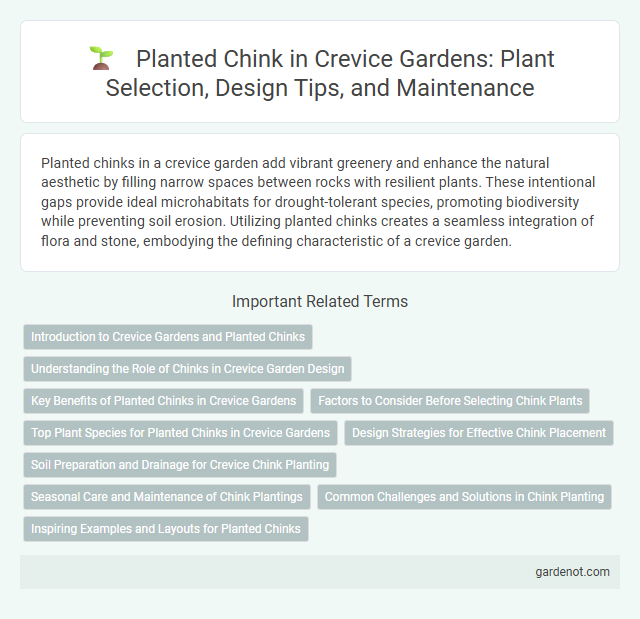Planted chinks in a crevice garden add vibrant greenery and enhance the natural aesthetic by filling narrow spaces between rocks with resilient plants. These intentional gaps provide ideal microhabitats for drought-tolerant species, promoting biodiversity while preventing soil erosion. Utilizing planted chinks creates a seamless integration of flora and stone, embodying the defining characteristic of a crevice garden.
Introduction to Crevice Gardens and Planted Chinks
Crevice gardens are unique rock formations designed to mimic natural stone crevices, ideal for growing drought-tolerant and alpine plants. Planted chinks refer to the narrow gaps or fissures between rocks where soil and plants are carefully placed to create microhabitats that support specialized flora. This gardening technique enhances drainage and aeration, promoting healthy root growth in challenging environments.
Understanding the Role of Chinks in Crevice Garden Design
Planted chinks in crevice garden design serve as narrow, soil-filled gaps between stones that create microhabitats for specialized alpine and rock garden plants. These chinks provide essential moisture retention, root protection, and temperature regulation, enabling plants to thrive in challenging conditions. Integrating chinks strategically enhances biodiversity and mimics natural rock formations, crucial for authentic crevice garden aesthetics.
Key Benefits of Planted Chinks in Crevice Gardens
Planted chinks in crevice gardens enhance microhabitats by providing stable moisture retention and nutrient-rich pockets essential for alpine and drought-tolerant species. These narrow soil-filled gaps improve root anchorage, preventing erosion while supporting biodiversity by hosting specialized plants rarely found in traditional garden settings. This naturalistic planting method optimizes vertical space, creating visually striking layers that mimic rugged mountainous environments.
Factors to Consider Before Selecting Chink Plants
Selecting chink plants for a crevice garden requires careful consideration of factors such as sunlight exposure, soil type, and moisture levels to ensure optimal growth. Plants with drought tolerance and shallow root systems are ideal for thriving in narrow crevices with limited soil. Additionally, choosing species that complement the garden's microclimate and aesthetic enhances both functionality and visual appeal.
Top Plant Species for Planted Chinks in Crevice Gardens
Sedum species, including Sedum album and Sedum acre, are top choices for planted chinks in crevice gardens due to their drought tolerance and shallow root systems. Saxifraga oppositifolia and Draba species thrive in crevice conditions, offering vibrant blooms and resilience to extreme temperature fluctuations. Other effective plants include Heuchera and Dianthus, which provide color contrast and adapt well to the limited soil depth of planted chinks.
Design Strategies for Effective Chink Placement
Planted chink design strategies emphasize optimal spacing to ensure healthy root growth and water drainage in crevice gardens. Selecting drought-tolerant, shallow-rooted species enhances stability and visual appeal within narrow gaps between rocks. Integrating organic mulch around chinks also aids moisture retention and temperature regulation, promoting plant vitality.
Soil Preparation and Drainage for Crevice Chink Planting
Planted chink in a crevice garden requires well-draining, sandy or gritty soil mixed with organic matter to promote root health and prevent waterlogging. Proper soil preparation includes loosening the soil within crevices and ensuring adequate depth to accommodate root growth while maintaining air circulation. Effective drainage is crucial, achieved by incorporating coarse materials like gravel or crushed stone beneath the planting zone to prevent moisture retention and root rot.
Seasonal Care and Maintenance of Chink Plantings
Planted chink areas in crevice gardens require seasonal care to ensure healthy growth and prevent weed intrusion. Regularly inspect gaps for debris buildup and remove dead or diseased foliage during spring and fall to promote air circulation and reduce fungal risks. Applying mulch in colder months helps retain moisture and protect roots from frost damage, supporting plant resilience through seasonal changes.
Common Challenges and Solutions in Chink Planting
Common challenges in planted chink include ensuring proper drainage to prevent waterlogging and root rot, managing soil erosion around the gaps, and selecting plant species that can thrive in narrow, constrained spaces. Solutions involve using well-draining soil mixtures, incorporating moisture-retentive yet porous substrates, and selecting drought-tolerant, low-maintenance plants like sedums and small ferns that stabilize soil and require minimal care. Routine monitoring and gentle weeding help maintain plant health and prevent invasive species from overwhelming the crevices.
Inspiring Examples and Layouts for Planted Chinks
Planted chinks in crevice gardens showcase a harmonious blend of rugged stone and delicate plant life, emphasizing drought-tolerant alpine species like sedums, saxifrage, and sempervivum. Effective layouts position narrow, linear gaps between tightly packed stones, mimicking natural mountain fissures to create microhabitats that encourage root establishment and water retention. Inspiring examples include the extensive crevice gardens at the Denver Botanic Gardens and the Royal Botanic Garden Edinburgh, where meticulous stone selection and plant pairing highlight both aesthetic appeal and ecological resilience.
Planted chink Infographic

 gardenot.com
gardenot.com